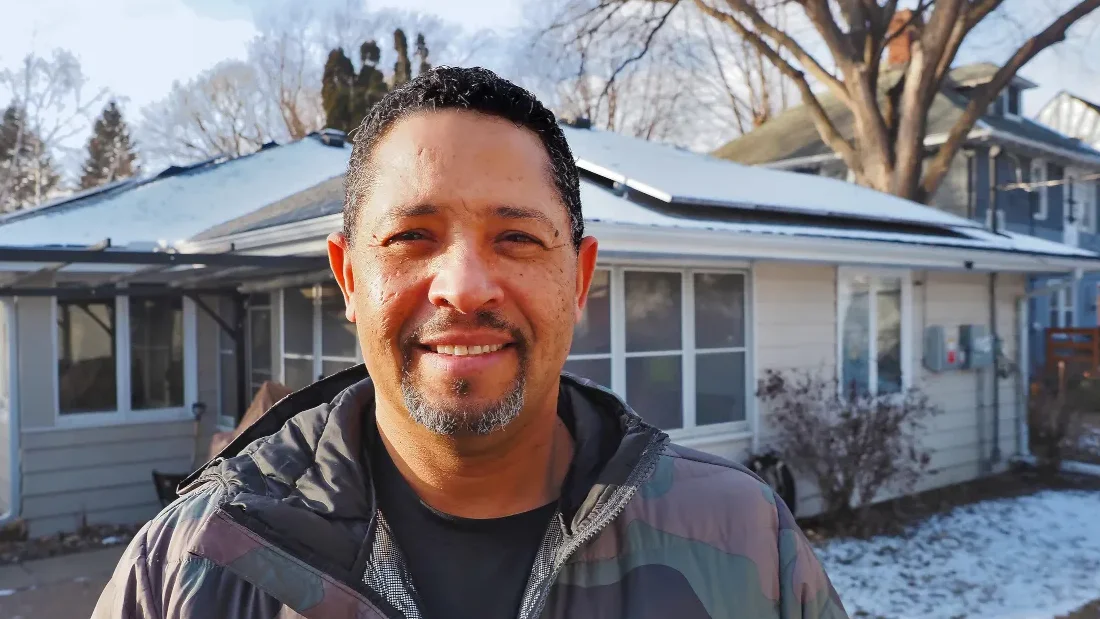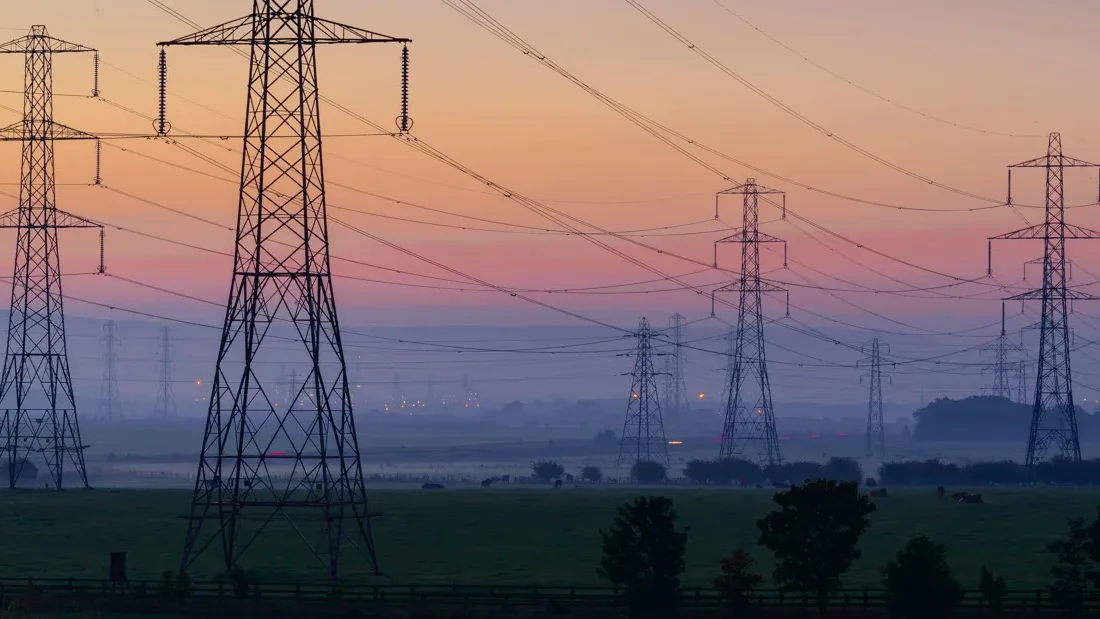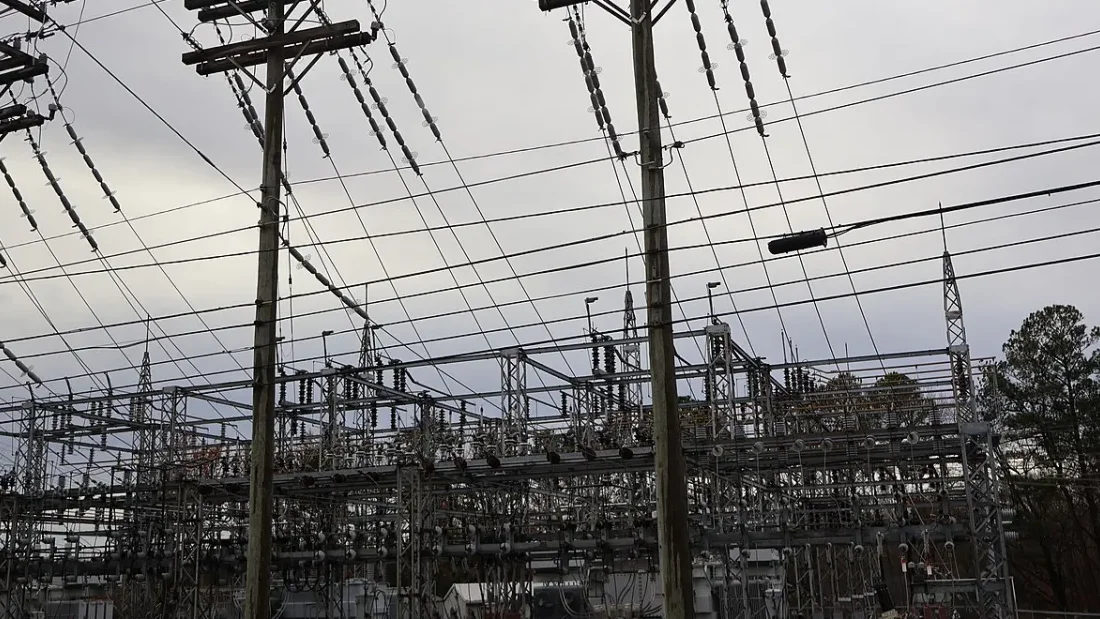
One installation at a time, a solar nonprofit that matches socially conscious investors’ cash with lower-income homeowners is spreading the benefits of solar in North Minneapolis.
Solstar was formed three years ago by solar entrepreneur Ralph Jacobson following his retirement from IPS Solar, the pioneering Twin Cities’ solar company he founded three decades ago earlier.
In his entire career, “I hardly ever had Black customers or Black subcontractors,” Jacobson recalled.
Solstar is a collective effort for clean energy leaders in North Minneapolis to address those racial disparities.
Jacobson, 71, works his network to persuade wealthy individuals to invest in residential solar installations. Kristel Porter, a well-known community activist, recruits low- or moderate-income homeowners who are interested in having solar on their homes. J.T. Thomas of the Black-owned Go Solar Construction trains and supervises students who help install the projects.
Solstar takes care of applications for all of the available incentives. Homeowners pay nothing and immediately benefit from a lower monthly electricity bill.
“It’s a no-brainer,” said Jacques Beech, who signed up with Solstar and now has solar panels on the roof of the 2,700-square-foot ranch home he shares with his wife and two kids.
His electricity bill so far has dropped by around $100 a month.
The model is working, though slower than Solstar’s founders would have hoped. The nonprofit initially wanted to finish 24 projects in its first two years. Instead, it’s completed ten and expects to hit the two dozen mark later this year.
“We found it has been harder than expected and needed a different skill set,” Jacobson said.
Among the challenges were managing investors, timing projects around incentives, convincing skeptical homeowners the offer wasn’t too good to be true, and keeping trainees employed in the still sporadic industry.
Solstar’s financing is complex. The nonprofit pays for installations by attracting investors and offering them a modest rate of return. Three major equity investors take advantage of the tax credits and depreciation on the projects. Solstar’s microlenders do not get tax credits but instead receive 3.5% on investments ranging from $5,000 to $50,000.
Solstar investors reduce their taxes by taking advantage of the 30% tax credit and a six-year depreciation schedule on solar projects. After exhausting tax incentives, Solstar plans to sell the solar systems to their commercial and residential customers at a significantly reduced price. Clients hosting Solstar panels on their roofs receive discounts on their electricity by as much as 20% and, in some cases, more.
Jacobson reduces his costs by taking advantage of other programs. Every project is sized up to 120% of the client’s electricity use, the highest amount allowed under Xcel Energy’s Solar Rewards incentive program. Solar Rewards pays more per kilowatt hour for participating low-income households. A production incentive from the city of Minneapolis’s Green Zone program adds another layer of support.
None of this is easily absorbed by investors or clients. Jacobson quickly discovered interested investors, but many would require multiple conversations and several weeks of consideration before betting on his new program.
Eventually, crowdsourcing cash paid off. “I certainly developed a bit of a following, a little community of maybe 70 to 75 people, who have put money into these projects,” he said.
One of those is Eric Pasi, a former partner at IPS Solar who now runs the community solar company Enterprise Energy. He saw an opportunity to move solar beyond helping reduce energy bills of middle- and upper-class clients to a BIPOC mixed-income neighborhood.
“We love projects like this because for a modest investment the impact for these projects is so great,” said Pasi, who is also a board member of Fresh Energy, which publishes the Energy News Network.
After Solstar began knocking on doors of North Minneapolis residents in early 2021, Jacobson discovered the annual budget for Xcel’s Solar Rewards program had already run out of money for the year. Porter kept marketing Solstar and speaking to potential clients to prepare installations for 2022 and 2023.
The Solar Rewards issue was just the start of problems. “I didn’t realize we were going to run into as many potholes as we ended up running into,” Porter said.
Some homeowners sat on the fence, not making a final decision for months. At least four who signed up in 2023 delayed solar projections because they needed new roofs after an August hail storm.
Trying to pay professional contractors and their trainees became expensive and “tricky and financially just too much,” Porter said.
Solstar eventually broadened the contractor pool beyond Go Solar to finish projects within the Solar Rewards deadlines. If a project does not meet deadlines, Solstar would have to reapply for Solar Rewards the following year “and go through the whole process again,” Porter said.
Other projects were slowed when Xcel laid off several employees who were familiar with Solstar and its model.
Solstar’s job training pipeline has also run into hurdles. Thomas onboards students from training programs offered by the city of Minneapolis and partnering institutions such as the Regional Apprenticeship Training Center. Four students who received classroom training then worked with Thomas on Solstar projects.
Some students struggle with getting transportation to installation jobs, he said. Training is often scheduled so far in advance that job opportunities may not be immediately available when students finish their classes.
Many students can’t spend a month or two waiting for a job, Thomas said, and when a job emerges, they may not be available because they are already working.
“It’s taken a while to ramp up, but now it seems like the jobs are trickling in and we’re getting the processes down,” he said. “Hopefully, as we go on to it next year, it will be a little more seamless.”
Still, according to attorney Jeremy Kalin, the program’s approach and hard-won success means that other nonprofits could use the same approach. His firm, Avisen, has worked with similar programs in Maryland and others are starting in Arizona, Georgia and New Mexico.
The difference between Solstar and those initiatives is that Jacobson recruited wealthy investors who could take advantage of the tax credits and depreciation. Nonprofits in other states will use the Inflation Reduction Act’s “direct pay” option rather than rely on investors. The act allows nonprofits and government agencies to receive tax credits as cashback from the IRS.
Nonprofits using direct pay did not have a way to “monetize the depreciation deduction,” but “they have a simpler task because finding tax credit investors with the right kind of taxable income is hard,” Kalin said.
Jacobson has not determined whether Solstar will continue the same structure or lean into direct pay. He said several early investors in Solstar and a separate initiative he helps lead in the Red Lake Indian community want to continue participating in Solstar.
Early customers like the program. Beech said he would have never made such a significant investment with such a long payback without the program. “It’s not a cost-effective thing, unless you just have the money, which I don’t,” Beech said. “This is an affordable way to do it.”
After completing the first iteration of Solstar, Jacobson wants to start another limited liability company and start recruiting 24 more homes and small businesses. “If White people can build wealth by owning solar, then I guess Black people should be able to build wealth by owning solar, too,” he said.

WIND: The Biden administration awards a northern California county $426.7 million to fund development of an offshore wind turbine assembly, construction and maintenance terminal. (Times-Standard)
SOLAR:
UTILITIES:
OIL & GAS: Alaska Gov. Mike Dunleavy calls on the state legislature to allocate another $4.5 million to boost a proposed liquefied natural gas pipeline and export project, but lawmakers are skeptical of the plan’s viability. (Northern Journal)
COAL:
ELECTRIC VEHICLES:
GEOTHERMAL: A Hawaii lawmaker proposes tackling rolling blackouts by tapping active volcanoes for geothermal power. (KHON2)
GRID:

OFFSHORE WIND: New Jersey regulators approve two new offshore wind farms as part of the state’s third solicitation: the 2.4 GW Leading Light and the 1.34 MW Attentive Energy 2 projects. (E&E News, Offshore Wind Biz)
ALSO:
POLICY: The question of how to pay for Maryland’s “comprehensive” climate plan is sure to be discussed during this upcoming legislative session, with no clear or easy answers in sight. (Maryland Matters)
CLIMATE:
MINING: A Pennsylvania nonprofit receives what is thought to be the largest grant the state has dispersed for abandoned coal mine cleanup, for a project near the Nanticoke Creek in the state’s northeast. (Bay Journal)
TRANSIT:
SOLAR:

CLEAN ENERGY: States bring in hundreds of millions of dollars each year in fossil fuel revenues, paying for schools and roads that will need to find other funding sources as states transition to renewables. (Axios)
EQUITY: As many as 1.5 million U.S. families could lose access to home heating assistance funds if Congress doesn’t include an additional $2 billion in aid in next year’s budget. (The Hill)
CLIMATE: House Republicans argue that the SEC’s upcoming rule requiring businesses to submit climate-related disclosures oversteps the agency’s authority based on a recent Supreme Court ruling. (Utility Dive)
NUCLEAR:
GRID: The North American Electric Reliability Corp. details a three-year plan for creating reliability standards for inverter-based resources including wind, solar and battery storage. (Utility Dive)
ELECTRIC VEHICLES: The Biden administration still needs to specify which parts of electric vehicle charging station construction can be paid for with newly detailed federal tax credits. (Canary Media)
SOLAR:
NATURAL GAS: Renewable energy advocates raise concerns about storing liquefied natural gas next to power plants, saying it doesn’t make sense to invest in gas as the country moves to renewables. (States Newsroom)
COAL: A Wyoming law requiring utilities to consider retrofitting aging coal-fired power plants with carbon capture rather than retiring them is increasing utility bills and could end up costing ratepayers billions of dollars. (WyoFile)
COAL ASH:

TRANSMISSION: Indigenous tribal nations and advocates file a federal lawsuit seeking to block a southern Arizona section of the SunZia transmission project, saying it imperils cultural resources. (Associated Press)
ALSO: U.S. Rep. Katie Porter, a California Democrat, says the relatively burdensome federal permitting process for new transmission lines is holding back the clean energy transition. (news release)
OIL & GAS:
UTILITIES:
ELECTRIFICATION: Washington state lawmakers revive an effort to ban large utilities from connecting natural gas lines to new residential or commercial buildings, with some exceptions. (KIRO)
ELECTRIC VEHICLES: A Colorado city uses a state grant to purchase a second electric fire engine. (Daily Camera)
CLEAN ENERGY: Republican Utah lawmakers push back on federal moves to replace fossil fuel power plants with clean energy, saying it could harm reliability and increase electricity rates. (Utah News Dispatch)
COAL: A Wyoming county rezones portions of a Powder River Basin coal mine to facilitate repurposing infrastructure for other uses after the operation closes. (WyoFile)
CLIMATE: Hawaii Gov. Josh Green revives a proposal to enact a $25 climate impact fee on visiting tourists, estimating it would generate more than $68 million annually. (Honolulu Civil Beat)
WIND: California agencies publish a draft offshore wind strategic plan identifying suitable development sites and potential impacts. (Riviera)
BATTERIES: An energy storage firm plans to launch programs incentivizing residential solar-plus-battery system deployment in Los Angeles County. (PV Magazine)
Editor’s note: Menlo Park, California, has stopped enforcing its ban on natural gas hookups in new buildings. Friday’s digest mistakenly said Palo Alto was halting enforcement of the rules.

OIL & GAS: Tennessee Valley Authority, Duke Energy and Georgia Power — three of the Southeast’s biggest utilities — want to build more natural gas-fired power into their long range plans, despite the Biden administration’s hopes for more carbon-free energy. (E&E News)
ALSO:
OVERSIGHT:
UTILITIES:
SOLAR:
EFFICIENCY: A Democratic West Virginia lawmaker spotlights job creation in an effort to win more support for legislation to spur energy efficiency programs in the state. (Mountain State Spotlight)
WIND: A Virginia judge dismisses lawsuits trying to block a planned 13-turbine wind farm atop a mountain. (Roanoke Times)
ELECTRIC VEHICLES:
CLEAN ENERGY: A Virginia commission to promote economic growth in former tobacco-producing areas announces a matching grant program that could deliver up to $12 million for “high-impact” energy projects. (Cardinal News)

GRID: Federal Energy Regulatory Commission Chairman Willie Phillips says recent winter storms highlight the need for “equitable and forward-thinking transmission solutions” to ensure long-term reliability. (Utility Dive)
ALSO: Texas’ power grid broke records for winter demand but withstood last week’s polar vortex, while a largely partisan debate continues over whether added renewables or natural gas facilities deserve more credit for avoiding outages. (Utility Dive, Inside Climate News)
ELECTRIC VEHICLES:
CLIMATE:
WIND:
OIL & GAS:
SOLAR: Tribal nations say Washington state’s solar permitting and siting process threatens cultural resources and Indigenous foodways by relying on often-inadequate developer-sponsored archaeological surveys. (High Country News)
UTILITIES: Xcel Energy wants time-of-use rates to be the default billing system for its Minnesota residential customers, proposing to double prices for power during peak late afternoon and early evening hours. (Energy News Network)
MINING: Advocates worry that a flurry of lithium, copper and other critical material mining proposals will further strain drought-stressed Southwestern water supplies. (Inside Climate News)
CLEAN ENERGY: A Michigan lawmaker says the timing of the federal Inflation Reduction Act was a significant reason why the state passed sweeping clean energy reforms last year. (Volts)

New Hampshire’s energy department is preparing to road-test a grant program meant to help disadvantaged cities and towns access the environmental and financial benefits of solar power.
The state plans to use $1.4 million from the 2021 federal Bipartisan Infrastructure Act to help fund the installation of solar projects up to 60 kilowatts on municipal buildings or land. The grant will cover up to 95% of the costs of a qualifying solar project for lower-income cities and towns and 60% for other municipalities.
In addition to cutting carbon emissions, solar can also make a community more resilient in case of power outages. And using it to power municipal facilities can save money that can be reinvested in public projects or used to hold down property tax rates in the long-term.
The funding application has been submitted to the U.S. Department of Energy, and New Hampshire is now in “wait-and-see mode,” said Joshua Elliott, director of policy and programs in the state energy department.
The state is also looking at the program as something of a trial run, to see if it makes sense to continue and expand the grant offering in the future.
“We’re looking at this program as almost the guinea pig to see what demand is out there, what can we do, what we can improve,” Elliott said. “Then we’ll use this process to inform what potentially a [larger] municipal program could look like.”
As a whole, New Hampshire lags the region in solar adoption. The state ranks 41st in the country for installed solar capacity, behind even lower-population New England states like Maine, Rhode Island, and Vermont, according to the Solar Energy Industry Association. State policies to encourage solar are limited, with incentives for residential solar maxing out at $1,000 per project and rebates for commercial solar limited to $10,000.
On the municipal level, though, many New Hampshire cities and towns are very interested in solar power. For example, in Hanover, a more affluent town and the home of Dartmouth College, solar arrays provide nearly all the power used by municipal facilities. Smaller towns and those with lower average incomes, however, often have a harder time realizing their solar goals.
New Hampshire property owners already have one of the highest property tax burdens in the country, so proposing that the residents of small, disadvantaged towns pay more to install solar is a big ask, even if there could be financial benefits down the line. Beyond the issue of funding, there are the logistics: researching options, hiring consultants, assessing different grant options.
“If you have the idea that you want solar on the town hall, you have to go from the idea to the implementation,” said Margaret Byrnes, executive director of the New Hampshire Municipal Association. “For municipalities that don’t have that internal staff, it’s a significant lift.”
The grant program aims to lighten that burden. And to maximize the benefits these towns can achieve, the grant guidelines encourage municipalities to skip entering into leasing arrangements and instead buy their solar arrays outright, so they retain the rights to sell renewable energy credits.
“We want all of those benefits flowing to the community itself,” Elliott said.
Colebrook, a town of roughly 2,000 people just 10 miles south of the Canadian border, is looking at the grant program as a potential way to fund a solar array on the roof of its town hall. Tourism is the main economic driver in the remote and scenic town, and there is little industry and few high-paying jobs. The median household income in town is just over $48,000, well below the state median of $91,000.
“We can’t just go out and ask for $150,000 from the town to foot the bill” for a solar project, said Colebrook town manager Tim Stevens. “Any time you have to go back to the town and ask for more money than you did before, that has a negative impact on them.”
Hinsdale, a small town near the state’s southern border, has plans to open its transfer station full-time and hopes to build a solar array on the site to help power the operation. A recent report, however, found that most residents’ property taxes had increased between 25% and 48% between 2018 and 2022, making it challenging to ask for yet more money. And there’s a bridge in town that needs to be rebuilt and other pressing infrastructure issues.
“Unfortunately, solar is not on that priority list,” said Josh Green, Hinsdale’s community development coordinator.
He estimates that a 60-kilowatt array at the transfer station would cost about $260,000. With the grant, the town would only have to pay about $13,000 of that total tab.
“The solar grant would definitely help the town out tremendously,” Green said.
Though the planned grant program is modest in size — the total budget will likely be able to fund only a handful of projects — it is well-tailored to the needs of the state, said Melissa Elander of Clean Energy New Hampshire, a nonprofit advocacy group that has been working with municipalities in the northern part of the state to prepare for the launch of the grants.
“It’s a good fit to focus on smaller towns that often get forgotten in some of the larger grant programs,” she said. “I am thrilled that it’s going to be available at all.”

Some environmental advocates are striking a new tone as they urge skeptical neighbors to see the larger climate benefits of a proposed port that would help build future offshore wind farms in the Gulf of Maine.
The fast-warming area of the North Atlantic is thought to have one of the world’s best wind resources in its deeper waters. Tapping into this huge renewable energy potential will likely require massive floating turbines, with a deepwater port to help construct and assemble them before they’re towed out to sea.
A state announcement on one of two potential port sites in the small Midcoast town of Searsport is expected in the coming weeks. Amid a record spate of destructive extreme weather events, conservation groups are stepping up calls for the public to back some version of the port project for the climate’s sake.
“The number one best thing to do for the environment is to get turbines in the water and start generating renewable energy,” said Nick Lund, the advocacy and outreach manager for Maine Audubon. “This is a larger question than just Searsport, because it really does affect all of us.”
Offshore wind is crucial to Maine’s goals for reducing its carbon emissions, Lund said, and offers a unique chance for the state to contribute its resources to the national and global fight against climate change.
Maine Audubon, which predates and is separate from the National Audubon Society, hopes to reframe the debate around the port and offshore wind in general as more than a “lesser of two evils,” he said.
“This type of turbine is not something that can be built elsewhere,” Lund said. “This is a real opportunity to generate a ton of energy completely locally. Other states, other countries don’t have this opportunity.”
Maine depends more on carbon-intensive fuel oil for home heating than any other state, importing it largely from Texas, Louisiana and Canada, according to federal data. The state has encouraged residents to switch to electric heat pumps and hopes to get 80% of its electricity from renewable sources by 2030.
But a boom in local solar projects has raised land-use concerns, and residents have repeatedly pushed back on transmission lines planned to bring Canadian hydropower or land-based wind from Northern Maine onto the regional grid. Some Maine fishing groups also oppose offshore wind development.
Lund said Maine Audubon is trying to turn toward saying “yes” rather than “no” to projects with a net benefit for the climate. The group has spent years developing habitat-minded siting guidance for solar developers, and executive director Andy Beahm wrote a newspaper commentary in 2023 urging support for offshore wind and calling climate change “the No. 1 threat to Maine wildlife and habitat.”
Around the same time, the National Audubon Society put out a report supporting transmission build-out for climate reasons despite potential impacts to birds. Environmentalist Bill McKibben also wrote that summer that “some NIMBY (not in my backyard) passion will need to be replaced by some YIMBY (yes in my backyard) enthusiasm — or at least some acquiescence” in order to fight the climate crisis equitably.
In an interview soon after his commentary was published, Beahm acknowledged that localized energy development may feel new to many Mainers: “Maine is highly dependent on others for our energy,” he said. “As a consequence, we haven’t had to see a lot of the power infrastructure from our communities.”
But his group and others are increasingly arguing that this needs to change. If Maine can’t tap into its offshore wind potential, it could see far more land used for solar, Lund said — or could help drive fossil fuel growth in already overburdened environmental justice areas of Appalachia and the Gulf South.
“If we say no to everything here,” Lund said, “someone else, someone with less power — their land is being developed.”
It will take a rare kind of port to help build and deploy turbine assemblies that are expected to be taller than the Washington Monument, with blades and installation vessels more than 400 feet long, according to a 2021 port feasibility study by the state Department of Transportation.
“Those locations in Searsport are, by far, the sort of best available — certainly in Maine and in New England,” Lund said. “Without a deepwater port, we’re simply not going to have floating offshore wind in the time that we need.”
The state has zeroed in on two potential wind port sites in Searsport: Mack Point, a piece of shoreline that now partly houses a Sprague Energy oil and cargo terminal; and Sears Island, a state-owned conservation area popular for birding and outdoor recreation.
Sears Island is one of the largest undeveloped islands in Maine, managed by a 2009 conservation easement that set about a third of its area aside for a potential future port. The island was unsuccessfully eyed for a nuclear plant, a coal plant, a container port and an LNG terminal in decades past, according to a state committee that overcame “years of acrimony and controversy” to negotiate the easement.
The 2021 study listed Sears Island as a preferable wind port site, partly because building one at Mack Point would require costly dredging. But some Mainers have pushed back hard against the idea of this use for part of DOT’s Sears Island set-aside, with officials predicting protest “sleep-ins” if they go this route.
A state working group has spent more than a year considering ways to minimize Mack Point’s potential cost and dredging issues — with buy-in from the site’s current owner, Sprague — and recent editorials in Maine newspapers have supported it as a better choice over Sears Island.
“Locating the offshore wind port at Mack Point consolidates industry in a single location and removes unused physical remnants of outdated energy production that offshore wind intends to replace with clean, renewable, more sustainable energy production,” Sierra Club Maine director Pete Nichols wrote in the Portland Press Herald on Jan. 18.
Lund said Maine Audubon agrees that Mack Point is the preferable site, and that choosing it could help the state avoid costly legal challenges. “And,” he said, “I’m better with delay than I am with not getting it built at all — that’s really the worst outcome.”
He said his group is most interested in seeing the project move forward, and in working to mitigate and offset any environmental impacts wherever it’s located.

GAS: Vermont’s top court dismisses a lawsuit against the state’s main gas utility that sought to prevent it from buying and distributing methane from a large New York landfill, a plan criticized by some as a greenwashing scheme. (Seven Days)
ALSO: Three oil tankers catch fire in Epping, New Hampshire, leading to a massive response from neighboring fire departments. (WMUR)
ELECTRIC VEHICLES:
SOLAR:
CLEAN ENERGY: Rhode Island’s Block Island is now running on only renewable energy, roughly six years after it became home to the country’s first offshore wind farm. (news release)
CLIMATE: A new study shows how New England states have seen a precipitous drop in snowpack since the 1980’s, a problem evident at the region’s mountain resorts, which increasingly rely on making their own snow. (Boston Globe, Stowe Reporter)
POLICY:
GRID: Relatively few power outages are being reported this morning across the region even though thousands lost power over the weekend amid a major winter storm. (PowerOutage.US, In-Depth NH, WGRZ, )
AFFORDABILITY: Connecticut politicians debate whether to direct surplus state funds to help shrink the unmet residential demand for heating bill financial assistance. (CT Mirror)
COMMENTARY: A New Hampshire farmer details how climate change has “upended” standard seasonal weather patterns over the past four decades and how that impacts his business. (Concord Monitor)